Many of you are aware that I recently traveled to Europe on a State Department sponsored exchange program for young political leaders. I learned more in 10 days than I will ever have time express in written words and most of it isn't appropriate for a real estate blog. But, I did take plenty of pictures of the amazing architecture we experienced.
AMSTERDAM
We had a 7 hour layover in Amsterdam, Netherlands on our way east. So, we decided to take a train into town and look around.
The old city center is very old. Many shops and buildings have the year they were constructed etched in the ornamentation. Many of these were constructed in the 1500's or 1600's.
The attention to detail is staggering.
As time has progressed, some buildings have been taken down and new ones constructed. Here is a good example of buildings from various eras of construction.
Many of the buildings along the Amstel river are sagging. The above example illustrates the problem. That isn't lens distortion you are seeing there. The buildings are simply out of plumb.
These three buildings are "fanning out". Moisture in the soil has caused the buildings to move over the past 500 years.
The city square has some amazing edifices dedicated to Royalty and government.
This building is The Dam - the Royal Palace.
After a brief stop at an outdoor cafe for breakfast along the Amstel river, we finally made our way back to the amazing central train station for a 20 minute ride back to the airport.
ZAGREB
Our next stop was in Zagreb, Croatia.
The airport was a lot smaller than I imagined for a city supporting a million people.
Croatia was a province of Yugoslavia after WWII and was governed by communists. The architecture of this period reflects the communist vision. Here are concrete block houses. The apartments are about $250/mo (1675 Kuna at todays exchange rate) if you are looking for a cheap place to rent.
Zagreb has a long Medieval history as a province of Hungary and the Austro-Hungarian Empire.
Many of the buildings we saw were dilapidated and in significant disrepair. Yet, many buildings were receiving a facelift as Croatia works its way out of a recent economic depression.
St. Martin's Church is the centerpiece of the government section of the city where parliament and other government buildings reside.
Just east of the parliament is St. Stephens Cathederal. It was constructed in the 1500's. The dual steeple configuration was constructed in the late 1800's after an earthquake destroyed the old steeple. Like so many buildings in the city. It is currently under renovation.
The Croatian and Zagreb coat-of-arms were laid in tile on the roof of St. Martin's church in the 1880's.
Here is the entrance to Hrvatska Sabor (Croatian Parliament).
St. Stephens Cathedral is remarkable.
The sheer size and ornamentation were remarkable and distinctly symbolic of Croatia's history. The west wall has galgolithic inscriptions using Croatia's old alphabet.
During Turkish raids in the 1500's a defensive wall was constructed around the cathedral.
A short walk from our hotel was the Swiss embassy.
A small chapel in the midst of downtown Zagreb's busiest night life area.
An scene from Croatia's Foreign Affairs building.
There are many museums in the city center.
We visited the city's university. The city skyline is dotted with many more modern high rise buildings.
Arched and domed brick ceilings were a prominent architectural feature of many places we visited. In this case, it was a restaurant.
BUDAPEST
We arrived in Budapest, Hungary after a 6 hour train ride. The following morning we began exploring the city.
There are three main bridges that connect the east and west sides of the city of Budapest. All of them were destroyed in WWII and reconstructed to their original specifications and grandeur.
After becoming the second capitol of the Austro-Hungarian Empire, Budapest experienced a construction boom. Most of the buildings in the city date to around the late 1800's. The city was built, razed, rebuilt, and razed again during successive wars over the centuries. Due to political intrigue, Budapest escaped most, but not all, of the bombing of WWII.
Hungary survived Nazi and Soviet occupations and have memorialized their experience in a museum on Andrassy Blvd.
The level of detail and craftsmanship at the Opera House was mindboggling.
Here is a building near the parliament with textured concrete.
Doors and windows are ornamented beautifully. Our visit took us to the Hungarian Parliament building. In case you are wondering, everything inside was covered in gold leaf. If it is out of reach and looks like gold, it is.
This is a cigar holder.
The House Chamber was breathtaking.
We were told that the cost to construct the building would have built a city for 40,000 people. While gothic in style, the building was completed in 1903 after 17 years of construction. The following day we visited the Presidential Palance and the Castle District.
The palace was one of the buildings destroyed in WWII. The palace was meticulously rebuilt and restored. We were fortunate to have the designer of the restoration as our tour guide.
Mattias Templum is a giant cathedral in the Castle District. It was constructed in its current gothic configuration in the late 1800's after being destroyed several times during war. The site has hosted several different designs of cathedrals over the centuries.
The Danube River divides the Buda and Pest sides of the city.
EGER
Our final stop was in Eger, Hungary to learn about a major cultural center in the country. Our first stop was at Eger Castle which is being restored.
This is what remains of a giant support column.
There were many subterranean passages.
This is a primitive seismograph that engineers used to determine where enemy forces might be digging tunnels to subvert the castle walls. It is basically a pan of water on legs. But, it served its purpose and prevented many assaults on the castle.
The castle overlooks the city of Eger.
And, in case we got out of line, they had the stocks ready.
We were also shown a special library that houses medieval books and codeces. The library was constructed in 1776.
The ceiling isn't domed but is painted to look that way.
This Romanesque Cathedral was constructed in the 1200's. The statues were added in the early 1800's during a remodel. The interior featured Roman arches and motifs.
Overall, the trip was amazing. I will definitely be going back.










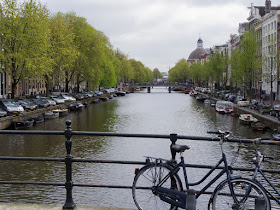

















































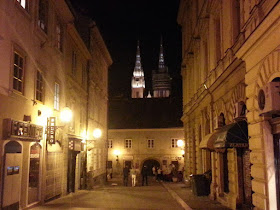













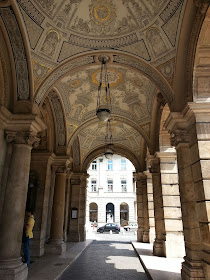







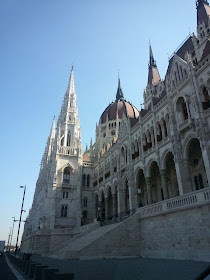








































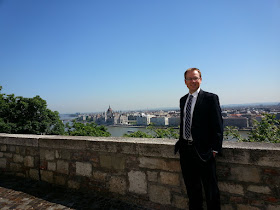






























No comments:
Post a Comment
Please keep comments appropriate and respectful for a real estate blog. Personal rants, spam, and off topic comments will be deleted.